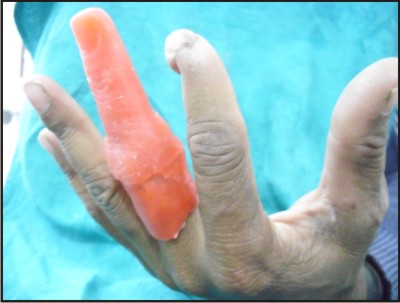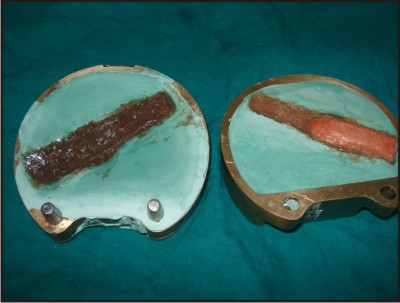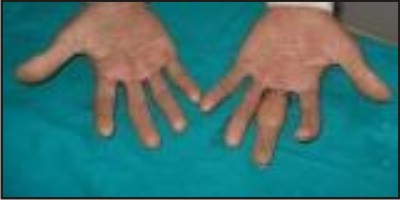Introduction
Finger or partial finger amputations are the most frequently encountered forms of partial hand loss . The most common causes of these amputations are traumatic injuries ,congenital absences or malformations which may present clinical challenges. Finger absence causes loss of grasp, security and marked psychological trauma.
Beasley has noted that individuals who keep their hands inside pockets due to embarrassment over appearance are as functionally disabled as a forequarter (scalpulothoracic) amputee.1
A precisely fitting prosthesis can improve function by restoring normal length , protecting a sensitive stump, maintaining sensitivity through a thin lamina and transmitting pressure and position sense for activities such as writing or typing. The gentle ,constant pressure of an silicone elastomer prosthesis can help desensitize and protect the injured tip.Individuals who desire finger replacement usually have high expectations for the appearance of the prostheses.2 Here ,the prosthetic management of a male patient with amputed middle finger was presented with less expensive and easily available silicone material.
Case Report
A 30 year old male patient was reported to the Department of Prosthodontics, Darshan Dental College Udaipur, Rajasthan for the replacement of the missing upper 1\3 rd part of middle finger of left hand . His chief complaint was loss of grip and ugly appearance. History reveals that the amputations occurred at the upper 1\3 rd part of middle finger 6 years back. He told about the injury. He works as a labourer in building construction and while breaking big stones he got injury in middle finger and index finger . After trauma upper 1/3 part of middle finger get amputed and index finger was disfigured. The surrounding area appeared to be normal with no signs of any inflammation . After clinical evaluation of the defect it was concluded that the amputed finger was acceptable for prosthetic rehabilitation . An informed consent was taken from the patient before starting the treatment to ensure his willingness and co-operation. This patient was convinced for rehabilitation of missing upper 1/3 rd part of middle finger with glove type finger prosthesis.
Procedure
Making of Impression : The patient hands were lubricated with petroleum jelly to prevent the impression material from sticking to the amputed site. Two big cardboa rd boxes were used for making the impressions of both the right and left hand using irreversible hydrocolloid impression material. The patient was instructed to keep the hands in normal resting position along with fingers and thumb apart , without stretching (Figure 1).
 | Figure 1 : Pretreatment Photographs Of Both Hands
 |
Preparation Of Models
The impressions were then poured in dental stone (kalabhai dental pvt ltd) using vibrator to avoid voids and the working casts of both hands were retrieved. Wax Pattern Fabrication and Try in - A donor was selected finding the same age ,sex and build as the patient and an putty impression of the left hand was made . The impression was poured in molten wax (modelling wax) and after cooling, the wax pattern was retrieved. The necessary modifications were made at chair side. The wax try in was done in the patient finger. During try in stage ,the fit, stability and seating of the wax pattern were evaluated along with the shape and size of the pattern (Figure 2).
 | Figure 2 : Model With Wax Pattern
 |
Nail bed preparation
An undercut was created beneath the cuticle margin that would function to retain the prefabricated artificial nail within the wax pattern. The nail was shaped according to the nail of the natural fingers.
Flasking and Dewaxing of Pattern
Putty wash technique was used to make impression of amputed stump and was poured in die stone. The pattern was transferred on the model and flasked to enhance the accuracy at the stage of shade matching such that the dorsal and the palmer aspects of the finger were separable, separating medium is applied between the two pours. After dewaxing ,the mould is allowed to cool (Figure 3).
 | Figure 3 : Dewaxing Of Wax Pattern
 |
Colour matching
Shade matching was done using natural daylight. The best time for this procedure was between 11 am to 1 pm .The room temperature vulcanising silicone(M P SAI mumbai) was used to matched intrinsically with the dorsal and palmer surface of finger. It is essential to carry out this procedure in front of the patient so as to gain approval.
Packing of Mould
Cyanoacrylate was painted to the artificial nail .Vaseline was applied to the mould. Mould was packed with silicone (Figure 4). The material was allowed to bench cured overnight .
Finishing of prosthesis
Once the final prosthesis was retrieved ,the flash was trimmed using a sharp blade .
Fitting and instructions
Slight extrinsic staining was done for exact matching of the shade.Though the fit of the prosthesis was quite satisfactory artificial rings was placed to hide the margins of the prosthesis(Figure 5 & 6).
 | Figure 4 : Packing Of Silicone Material In Mould
 |
 | Figure 5 : Glove Type Finger Prosthesis Dorsal View
 |
 | Figure 6 : Glove Type Prosthesis Palmer View
 |
Patient was demonstrated about the use and maintenance of the prosthesis. Patient was instructed not to expose the prosthesis to high temperatures, and sunlight and not to smoke as it stains the prosthesis yellow.
Discussion
Currently many traumatically amputed digits can be saved by microsurgical replantation or osseointegrated digital prosthesis .In some cases, however reconstruction is contraindicated or patient economic conditions preclude such treatment options. Prosthetic replacement of fingers can be satisfactory in patients who have atleast 1.5 cm of residual stump. The osseointegrated digital prosthesis is an alternate technique for patients with short stump on which a standard digital prosthesis attaches securely by means of an osseointegrated implant placed on intramedullary canal of residual bone of the amputed digit.3
In a study by Manurangsee et al, acrylic resin prostheses were fabricated and firmly attached to the abutments using hexagonal magnetic suprastructure system.4
Lundborget al rehabilitated 3 patients with traumatic thumb amputations with implant retained silicone thumb prosthesis.5
Advantage of intrinsic colouration is increased service life of prosthesis. Disfigured index finger can be corrected only by plastic surgery and not by prosthetic means. Hence glove type finger prosthesis was fabricated only for middle finger.
Conclusion
A convenient and affordable method of prosthetic rehabilitation of an amputed finger with room temperature vulcanising silicone material has been presented.The custom made glove type finger prosthesis is esthetically acceptable and comfortable in patients with amputed fingers ,resulting in psychological improvement and personality.Patient was highly satisfied with this prosthesis in terms of retention ,function and esthetics. The morale of the patient was also boosted to a great extent.
References
1. Beasley R J general consideration in managing upper limb amputation orthop clinics of northamerica 1981:12;4 ,743-749.
2. John W Michael ,Horst Bucknor -Journal of prosthodontics and orthoptics 1994,vol 6,nu 1, 10-15.
3. Cemal Aydin, Secil Karakora, Handan Yilmaz et al -The use of dental implants to retain thumb prosthese: a short term evaluation of 2 cases , Int J Prosthodont 2008;21:138-140.
4. ManurangseeP, IssariyawutC,Chatuthong V et al-Osseointegrated prosthesis: an alternative method for finger reconstruction. J Hand surg(Am)2000;25:86-92.
5. LundborgG ,BranemarkPL, Rosen b et al- Osseointegrated thumb prostheses: a concept for fixation of digit prosthetic devices,J hand Surg 1996;21:216-221. |